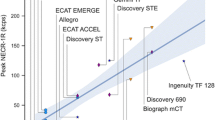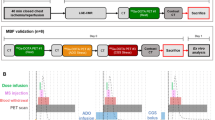Abstract
Purpose
The aim of this study was to establish a protocol for measuring myocardial blood flow (MBF) by PET/CT in healthy cats. The rationale was its future use in Maine Coon cats with hypertrophic cardiomyopathy (HCM) as a model for human HCM.
Methods
MBF was measured in nine anaesthetized healthy cats using a PET/CT scanner and 13NH3 at rest and during adenosine infusion. Each cat was randomly assigned to receive vasodilator stress with two or three adenosine infusions at the following rates (μg/kg per minute): 140 (Ado 1, standard rate for humans), 280 (Ado 2, twice the human standard rate), 560 (Ado 4), 840 (Ado 6) and 1,120 (Ado 8).
Results
The median MBF at rest was 1.26 ml/min per g (n = 9; range 0.88–1.72 ml/min per g). There was no significant difference at Ado 1 (n = 3; median 1.35, range 0.93–1.55 ml/min per g; ns) but MBF was significantly greater at Ado 2 (n = 6; 2.16, range 1.35–2.68 ml/min per g; p < 0.05) and Ado 4 (n = 6; 2.11, 1.92–2.45 ml/min per g; p < 0.05). Large ranges of MBF values at Ado 6 (n = 4; 2.53, 2.32–5.63 ml/min per g; ns) and Ado 8 (n = 3; 2.21, 1.92–5.70 ml/min per g; ns) were noted. Observed adverse effects, including hypotension, AV-block and ventricular premature contractions, were all mild, of short duration and immediately reversed after cessation of the adenosine infusion.
Conclusion
MBF can be safely measured in cats using PET. An intravenous adenosine infusion at a rate of 280 μg/kg per minute seems most appropriate to induce maximal hyperaemic MBF response in healthy cats. Higher adenosine rates appear less suitable as they are associated with a large heterogeneity in flow increase and rate pressure product, most probably due to the large variability in haemodynamic and heart rate response.


Similar content being viewed by others
References
Kaufmann PA, Gnecchi-Ruscone T, Yap JT, Rimoldi O, Camici PG. Assessment of the reproducibility of baseline and hyperemic myocardial blood flow measurements with 15O-labeled water and PET. J Nucl Med 1999;40:1848–56.
Wyss CA, Koepfli P, Fretz G, Seebauer M, Schirlo C, Kaufmann PA. Influence of altitude exposure on coronary flow reserve. Circulation 2003;108:1202–7.
Jagathesan R, Kaufmann PA, Rosen SD, Rimoldi OE, Turkeimer F, Foale R, et al. Assessment of the long-term reproducibility of baseline and dobutamine-induced myocardial blood flow in patients with stable coronary artery disease. J Nucl Med 2005;46:212–19.
Siegrist PT, Gaemperli O, Koepfli P, Schepis T, Namdar M, Valenta I, et al. Repeatability of cold pressor test-induced flow increase assessed with H215O and PET. J Nucl Med 2006;47:1420–26.
Kaufmann PA, Camici PG. Myocardial blood flow measurement by PET: technical aspects and clinical applications. J Nucl Med 2005;46:75–88.
Uren NG, Crake T, Lefroy DC, de Silva R, Davies GJ, Maseri A. Delayed recovery of coronary resistive vessel function after coronary angioplasty. J Am Coll Cardiol 1993;21:612–21.
Camici P, Chiriatti G, Lorenzoni R, Bellina RC, Gistri R, Italiani G, et al. Coronary vasodilation is impaired in both hypertrophied and nonhypertrophied myocardium of patients with hypertrophic cardiomyopathy: a study with nitrogen-13 ammonia and positron emission tomography. J Am Coll Cardiol 1991;17:879–86.
Dayanikli F, Grambow D, Muzik O, Mosca L, Rubenfire M, Schwaiger M. Early detection of abnormal coronary flow reserve in asymptomatic men at high risk for coronary artery disease using positron emission tomography. Circulation 1994;90:808–17.
Kaufmann PA, Gnecchi-Ruscone T, di Terlizzi M, Schafers KP, Luscher TF, Camici PG. Coronary heart disease in smokers: vitamin C restores coronary microcirculatory function. Circulation 2000;102:1233–8.
Kaufmann PA, Gnecchi-Ruscone T, Schafers KP, Luscher TF, Camici PG. Low density lipoprotein cholesterol and coronary microvascular dysfunction in hypercholesterolemia. J Am Coll Cardiol 2000;36:103–9.
Jenni R, Wyss CA, Oechslin EN, Kaufmann PA. Isolated ventricular noncompaction is associated with coronary microcirculatory dysfunction. J Am Coll Cardiol 2002;39:450–4.
Cecchi F, Olivotto I, Gistri R, Lorenzoni R, Chiriatti G, Camici PG. Coronary microvascular dysfunction and prognosis in hypertrophic cardiomyopathy. N Engl J Med 2003;349:1027–35.
Jorg-Ciopor M, Namdar M, Turina J, Jenni R, Schwitter J, Turina M, et al. Regional myocardial ischemia in hypertrophic cardiomyopathy: impact of myectomy. J Thorac Cardiovasc Surg 2004;128:163–9.
Maron BJ. Hypertrophic cardiomyopathy. Lancet 1997;350:127–33.
Meurs KM, Sanchez X, David RM, Bowles NE, Towbin JA, Reiser PJ, et al. A cardiac myosin binding protein C mutation in the Maine Coon cat with familial hypertrophic cardiomyopathy. Hum Mol Genet 2005;14:3587–93.
Meurs KM, Norgard MM, Ederer MM, Hendrix KP, Kittleson MD. A substitution mutation in the myosin binding protein C gene in ragdoll hypertrophic cardiomyopathy. Genomics 2007;90:261–4.
Kittleson MD, Meurs KM, Munro MJ, Kittleson JA, Liu SK, Pion PD, et al. Familial hypertrophic cardiomyopathy in maine coon cats: an animal model of human disease. Circulation 1999;99:3172–80.
Weissel M, Brugger G, Raberger G, Kraupp O. The effects of adenosine on coronary conductance, cardiac dynamics and myocardial metabolism of the isolated perfused cat heart. Pharmacology 1974;12:120–8.
Breisch EA, Houser SR, Carey RA, Spann JF, Bove AA. Myocardial blood flow and capillary density in chronic pressure overload of the feline left ventricle. Cardiovasc Res 1980;14:469–75.
Koepfli P, Hany TF, Wyss CA, Namdar M, Burger C, Konstantinidis AV, et al. CT attenuation correction for myocardial perfusion quantification using a PET/CT hybrid scanner. J Nucl Med 2004;45:537–42.
Muzik O, Beanlands RS, Hutchins GD, Mangner TJ, Nguyen N, Schwaiger M. Validation of nitrogen-13-ammonia tracer kinetic model for quantification of myocardial blood flow using PET. J Nucl Med 1993;34:83–91.
Koepfli P, Wyss CA, Namdar M, Klainguti M, von Schulthess GK, Lüscher TF, et al. Beta-adrenergic blockade and myocardial perfusion in coronary artery disease: differential effects in stenotic versus remote myocardial segments. J Nucl Med 2004;45:1626–31.
Hutchins GD, Schwaiger M, Rosenspire KC, Krivokapich J, Schelbert H, Kuhl DE. Noninvasive quantification of regional blood flow in the human heart using N-13 ammonia and dynamic positron emission tomographic imaging. J Am Coll Cardiol 1990;15:1032–42.
Hutchins GD, Caraher JM, Raylman RR. A region of interest strategy for minimizing resolution distortions in quantitative myocardial PET studies. J Nucl Med 1992;33:1243–50.
Wyss CA, Koepfli P, Mikolajczyk K, Burger C, von Schulthess GK, Kaufmann PA. Bicycle exercise stress in PET for assessment of coronary flow reserve: repeatability and comparison with adenosine stress. J Nucl Med 2003;44:146–54.
Chareonthaitawee P, Kaufmann PA, Rimoldi O, Camici PG. Heterogeneity of resting and hyperemic myocardial blood flow in healthy humans. Cardiovasc Res 2001;50:151–61.
Croteau E, Benard F, Bentourkia M, Rousseau J, Paquette M, Lecomte R. Quantitative myocardial perfusion and coronary reserve in rats with 13N-ammonia and small animal PET: impact of anesthesia and pharmacologic stress agents. J Nucl Med 2004;45:1924–30.
Herrero P, Kim J, Sharp TL, Engelbach JA, Lewis JS, Gropler RJ, et al. Assessment of myocardial blood flow using 15O-water and 1-11C-acetate in rats with small-animal PET. J Nucl Med 2006;47:477–85.
Hodgson DS, Dunlop CI, Chapman PL, Grandy JL. Cardiopulmonary effects of anesthesia induced and maintained with isoflurane in cats. Am J Vet Res Med 1998;59:182–5.
Acknowledgments
We would like to thank Ratko Milovanovic for data acquisition, Sabine B.R. Kaestner for help with planning and monitoring anaesthesia, Claudia E. Reusch for helpful discussions, Stefan Schellenberg for excellent support in preparing the manuscript, and Ingrid Vitali for providing the Maine Coon cats. The study was supported by a grant from the Swiss National Science Foundation (SNSF professorship grant no PP00A-114706).
This work was presented in part at the 15th European College of Veterinary Internal Medicine Companion Animal Congress, Glasgow, UK, 1–3 September 2005.
Author information
Authors and Affiliations
Corresponding author
Rights and permissions
About this article
Cite this article
Jenni, S.D., Schepis, T., Jenni, R. et al. Protocol for measuring myocardial blood flow by PET/CT in cats. Eur J Nucl Med Mol Imaging 36, 244–249 (2009). https://doi.org/10.1007/s00259-008-0950-7
Received:
Accepted:
Published:
Issue Date:
DOI: https://doi.org/10.1007/s00259-008-0950-7




